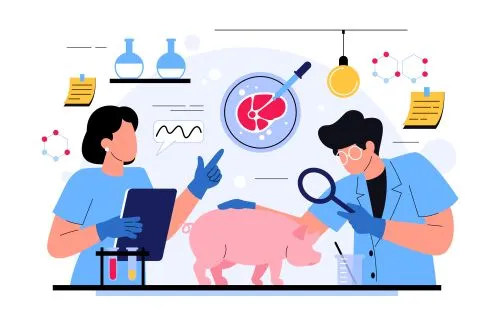
Packaging is often criticized today, especially if it is made of plastic. This criticism revolves around issues such as excessive waste, CO2 emissions, and resource consumption. Its most crucial function is often overlooked: protecting products so that they reach consumers undamaged. Packaging is essential for this purpose. It makes goods transportable and storable, ensuring hygiene, quality, authenticity, and the integrity of goods, especially food and pharmaceutical products, without which many goods would end up unused and wasted.
Good packaging
Good packaging optimally protects its contents; this is its main task. Nowhere is this as clear or as important as in the food sector. Innovative and intelligent packaging solutions play a decisive role in minimizing food waste.
At last year's Interpack, visitors learned, among other things, how to minimize food losses during the filling process, achieve reliable product inspection and high-quality sealing, and avoid unwanted contamination.
What is often not mentioned in the packaging debate is that only a small part of the climate impact of products, especially food, is due to packaging. For example, packaging for butter contributes only 0.4% to the carbon footprint of the entire product, and a milk carton about four percent.
The entire life cycle of the packaging is considered, including its disposal, as established in a study by the Packaging + Environment Working Group (AGVU). By far, the majority of the climate impact comes from the packaged product itself.
However, around one-third of the food produced worldwide is lost or wasted in the value chain each year. The SAVE FOOD initiative, launched in 2011 by Messe Düsseldorf and Interpack, aims to address this issue. Packaging plays a crucial role in their programs.
Safe food packaging
Food is still packaged in multilayer plastic composites because the different layers can be easily adapted to the protection needs of the respective product. However, multilayer packaging is currently not recyclable and thus ends up in landfills or is thermally recycled.
As part of the Circular FoodPack research project running until 2024, scientists at the Fraunhofer IVV Institute are currently working on recycling food packaging in a closed loop and making it usable for direct contact with food. To achieve this, they are developing innovative monomaterial packaging that is not inferior to multilayer composites in terms of its protective function but allows closing the loop through recycling and reuse.
To reuse recycled materials in food packaging, strict legal requirements must be met. The European Regulation 2022/1616 on recycled plastic materials and articles intended to come into contact with food imposes verifiable functional barriers for reuse in food packaging.
Therefore, Fraunhofer IVV has developed a screening method for the functional barrier layers intended to prevent the migration of unwanted substances into food. For this purpose, thin organic and inorganic coatings have been examined as a barrier layer and tested in use as the project progressed.
Paper is not always the first choice when it comes to packaging food, especially those with liquid or greasy ingredients. Fiber-based materials do not always meet the necessary barrier properties.
Compostable plastic
On the other hand, there is a trend away from plastic packaging towards paper-based packaging. When packaging comes into contact with liquid or greasy products, barrier protection is a key feature. BASF provides a solution with ecovio, its certified compostable plastic based on renewable raw materials. This year, the company expanded its ecovio portfolio for extrusion-coated paper and cardboard packaging with a new type.
It is approved for food contact and has good barrier properties against liquids, oils, fats, and mineral oils, as well as good temperature resistance up to boiling water at 100°C. Additionally, ecovio adheres very well to many paper and cardboard surfaces.
This makes the new type suitable for paper-based solutions such as cups and containers for dairy products, frozen food packaging, sandwich and muesli bar packaging, trays for confectionery and snacks, and cups for hot and cold drinks or soups. Important for economic efficiency:
According to the manufacturer, the coating speed of the new extrusion layer is comparable to that of polyethylene (PE). And, depending on the application and equipment, similar layer weights as with PE can be achieved—thus, very thin coatings are possible.
A waste reduction system
Currently, smart closure systems are used to minimize food waste. This year, United Caps introduced Bump Cap, a closure that allows surpassing the consumption limit date, which is now set too cautiously, without risk to the consumer.
The closure is automatically activated by the consumer when opening the cap for the first time with a twisting motion. As long as the cap surface is smooth, the product is still fresh.
However, if the film feels rough, it is a clear sign to the consumer that the expiration date has passed. The idea came from the London-based start-up Mimica, whose founder Solveiga Pakštaitė initially wanted to develop only a glass cap that would provide people with limited visibility with information about the product's shelf life.
The protective cap reaches the bottling plant in two parts. The base of the cap has been tested by the leading bottling equipment manufacturers; processing them requires only minor modifications to the system.
The cap is equipped with a bumpy surface, gel, and activator and is applied after filling with the help of a special machine. Like other modules, such as for labeling or film packaging, this machine can be easily integrated into production.
Remove foreign objects and errors
Inspection solutions are of great importance for the safety of product packaging. There are various systems on the market that can detect different types of foreign objects. For metals, industrial metal detectors are ideal for reliably detecting metallic foreign bodies and removing them from production lines.
These help manufacturers maintain compliance, minimize the risk of recalls, and reduce production downtime. If other foreign bodies need to be detected, X-ray inspection systems are recommended. This year, Mettler-Toledo demonstrated a new X-ray solution that inspects individually packaged food or pharmaceutical products at high speeds on production lines.
Checking labels, prints, or the expiration date before use is also important for product safety. Here, systems for visual product inspection provide precise results.
VisioPointer from Minebea Intec, for example, operates as standard with three cameras, various types of lighting, and optional side and satellite cameras for multi-page analysis. In addition, it offers reliable inspection of seal seams. This inspection is an important visual check of quality in the food sector, as the product's expiration date can only be achieved with tightly sealed packaging.
Sustainable protection against counterfeiting
Anti-counterfeiting protection is another major product safety issue that primarily affects pharmaceutical products. Security labels, for example, ensure that attempts to open the door are clearly visible.
However, when used on pharmaceutical folding boxes, they hinder recycling because part of their film remains firmly on the cardboard packaging. Securikett has now developed sustainable and ecological paper security labels with an integrated opening blade and a peel-off barrier. The "It's Paper" family now includes a wide range of diverse paper labels equipped with a variety of security features and can be easily recycled with cardboard.
Brand new for anti-corrosion protection
Secure packaging that optimally protects its contents is indispensable not only for food and pharmaceuticals. Even non-food products, such as metal components, often require more than a simple protective cover. Packaging must also provide protection against corrosion during transport.
Packaging manufacturer Antalis has grouped its experience under its own corrosion protection brand from 2023. Korus offers VCI paper and films for the European market. Volatile Corrosion Inhibitor (VCI) is a special volatile active ingredient that, as a carrier layer on paper or film, evaporates permanently in a sealed package, thus forming a protective atmosphere around the sensitive metal.
After opening the packaging, the inhibitor evaporates without leaving residues, unlike oils or fats, which are also used as corrosion protection. However, it is possible to open it for a short time, such as in customs, without losing corrosion protection. The protective atmosphere is automatically restored after closing.
The new Korus VCI papers and films from Antalis are recyclable after use. The company also has in its range a type of VCI paper that can be creped, maximizing the surface and allowing the entry of even more VCI active ingredients into the packaging.
Creping also makes the paper more elastic and pliable, so even sharp corners and edges can be safely enclosed.





